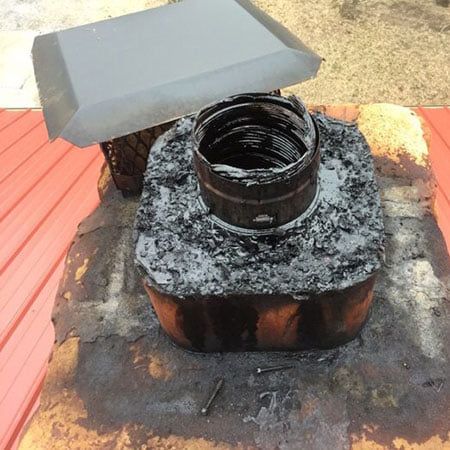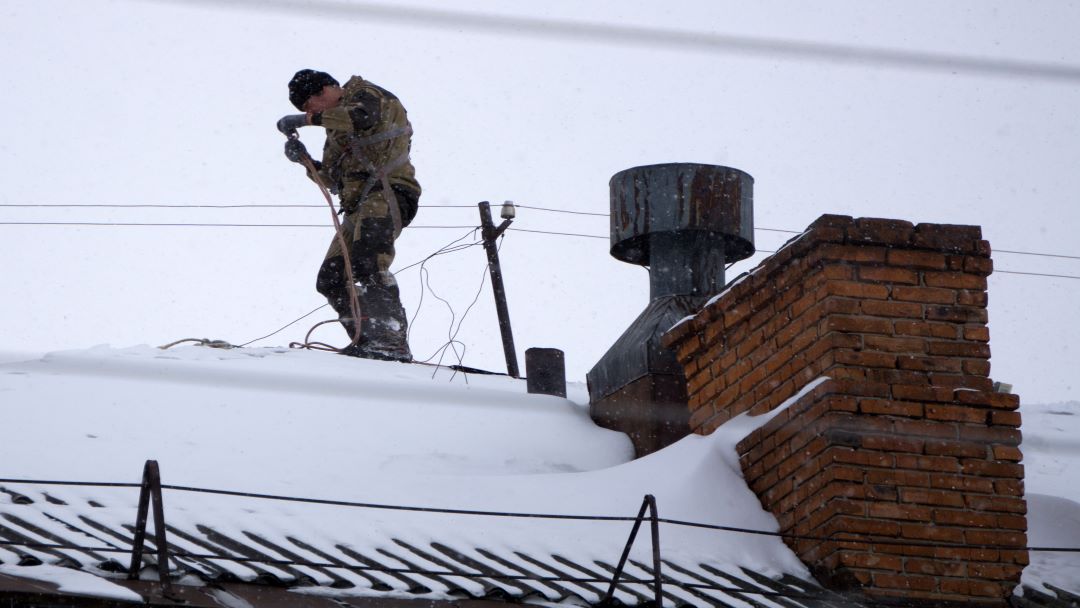Enjoying your fireplace shouldn’t pose a threat to your home. Unfortunately, it can if your fireplace system does not have the necessary safety components that it should. All it takes to spark a house fire is for a stray ember to ignite a nearby piece of furniture or shingle on the roof. Spark arrestors prevent this from happening.
What is a Spark Arrestor and How Does it Work?
A chimney spark arrestor is a device that helps to catch and stop sparks or embers from the flue and ignite nearby flammable materials, such as debris on the roof or ground. These sparks can come from open wood-burning stoves or fireplaces. They are durable enough to withstand the hot temperatures of the fire and hot embers. They are available in many shapes and sizes to fit every type of fireplace and chimney. Every home with a fireplace should have both types of spark arrestors; interior spark arrestors and exterior spark arrestors.
Interior Spark Arrestors
An interior spark arrestor plays an important role in protecting children and pets from stray sparks as well as your furniture and home. The main type of interior spark arrestor is a hearth screen. Hearth screens can be metal curtains that are a part of the fireplace, or stand-alone screens. Glass fireplace doors can also act as a hearth screen. Since interior spark arrestors are a part of the fireplace display, they are designed to be attractive and functional. There are many different styles and designs to choose from. No matter what type of interior spark arrestor you have, correct fit and proper installation are key to ensure it properly protects your home and loved ones.
Exterior Spark Arrestors
An exterior spark arrestor is installed at the top of the chimney to prevent stray sparks from igniting the roof or nearby trees. Along with preventing a house fire, it also prevents animals from entering and nesting in the flue. Since it is out of sight, it is not designed to be decorative. Usually, it is attached to the bottom of a chimney cap or rain cover.
How Does A Chimney Spark Arrestor Work?
Imagine you’re sitting by the fireplace on a cold winter night. The flames are crackling, and the wood is burning brightly. Suddenly, you see a shower of sparks coming up the chimney!
Luckily, your chimney is equipped with a spark arrestor, which prevents these burning embers from escaping into the open air. But how does this simple device work?
At its most basic, a chimney spark arrestor is a metal mesh screen covering the top. This screen prevents stray sparks from escaping while allowing smoke and hot air to ventilate.
Most chimney spark arrestors are made of stainless steel, which can withstand high temperatures without corroding. In addition to keeping your home safe from stray sparks, a chimney spark arrestor also helps to keep your chimney clean.
Over time, soot and ash can build up on the mesh, easily be remedied with a quick sweep of the chimney. So next time you’re sitting by the fire, you can rest assured that your chimney spark arrestor is doing its job!
How Does A Spark Arrestors For Chimneys Look Like?
A chimney spark arrestor typically consists of a metal mesh screen that covers the top of the chimney. This screen can be made of stainless steel or another fire-resistant material.
The mesh is usually attached to a metal frame that fits snugly around the chimney. In some cases, the mesh may be welded directly to the chimney.
Most chimney spark arrestors have a metal lip that extends down the side of the chimney. This lip helps to prevent sparks from escaping around the edge of the screen.
Chimney spark arrestors come in various sizes and shapes to fit all types of chimneys. The size of your spark arrestor will depend on the size of your chimney opening.
Spark arrestors are usually available in round, square, or rectangular shapes. You can also find spark arrestors specifically designed for oil-burning furnaces and wood-burning stoves.
Do I Need A Spark Arrestor On My Chimney
In most cases, yes! Many local building codes require chimney spark arrestors in residential and commercial buildings.
If you’re unsure whether your chimney needs a spark arrestor, the best course of action is to check with your local building code enforcement office, and they will be able to tell you the requirements for your area.
Even if your local codes don’t require a chimney spark arrestor, having one is still a good idea. After all, it’s better to be safe than sorry when preventing fires!
‘Usually, it is attached to the bottom of a chimney cap or rain cover. Whether you have a wood burning fireplace or gas fireplace, it is important to have spark arrestors. If you notice that your home lacks either one, you need to have it installed as soon as possible.’https://www.mychimney.com/uncategorized/difference-exterior-interior-spark-arrestors
Benefits Of Chimney Spark Arrestors
Having a spark arrestor on your chimney is necessary for many homes and has some great benefits. These include, but are not limited to:
- Preventing Fires – One of the main benefits of having a chimney spark arrestor is that it can help prevent fires. This is a significant benefit if you live in an area where wildfires are expected. Moreover, if you live in an area with a lot of dry brush, then a chimney spark arrestor can help keep your home safe.
- Protecting Your Home – If a fire starts, the spark arrestor will help to contain the fire and prevent it from spreading. This can help to minimize the damage that is done to your home.
- Saves You Money – This might not be straightforward, but it is still a benefit. Having a chimney spark arrestor can prevent fires and save money on your insurance premiums. This is because insurance companies often give discounts to homeowners who have taken steps to prevent fires.
- Keeping Your Family Safe – Finally, having a chimney spark arrestor can help keep your family safe. If a fire starts, the spark arrestor will help to contain the fire and prevent it from spreading, and this can help keep your family safe from harm.
Is A Chimney Cap The Same As A Spark Arrestor?
A chimney cap is not the same as a spark arrestor. While a chimney cap and a spark arrestor may sound or look the same, they serve two different purposes.
These two devices confuse many homeowners because they sit on top of the chimney but are different.
A spark arrestor has wire mesh placed over the opening to prevent sparks, while a chimney cap has a solid cover or screen that goes over the opening.
It would help if you had both a chimney cap and a spark arrestor for your chimney to be safe. The chimney cap will keep animals and debris from getting into your chimney, while the spark arrestor will keep sparks from escaping and starting a fire.
It’s best to consult a professional to see what type of chimney cap and spark arrestor you need for your home. A professional can also help you with installation.
Chimney Spark Arrestor Requirements
There are four main requirements for a chimney spark arrestor, as described by UpCodes. These include:
- The spark arrestor’s net-free area shall be at least four times the net-free area of the chimney outlet.
- The spark arrestor screen must have comparable heat and corrosion resistance to 19-gauge galvanized or 24-gauge stainless steel.
- Openings should not allow spheres with a diameter of more than 1/2 inch (12.7 mm) through, nor should they obstruct the passage of spheres with a diameter of less than 3/8 inch (9.5 mm).
- The spark arrestor should be readily available for cleaning, and the chimney cap or screen should be removable to allow for chimney flue cleaning.
How to Install a Chimney Spark Arrestor
Installing a chimney spark arrestor is a relatively simple process, and you can install most types without the help of a professional. We list the step-by-step instructions below.
DIY Disclaimer
We recommend that you consult a professional if you are uncomfortable performing this installation. This guide is meant to serve as a reference for those comfortable completing the installation independently.
Before You Begin
There are a few things you’ll need before you start installing your chimney spark arrestor:
- A ladder: You’ll need a ladder tall enough to reach the top of your chimney.
- A screwdriver: This will be used to remove the cap from the chimney.
- The spark arrestor: Make sure you have the correct size and type of arrestor for your chimney.
- A brush: You’ll use this to clean the inside of the chimney.
Step 1: Remove The Chimney Cap
If you have a chimney cap, the first step is to remove it. You can do this with a screwdriver. Once the cap is off, set it aside in a safe place.
Step 2: Inspect The Chimney
Now that the cap is off, take a look inside the chimney. If you see any soot or debris, use a brush to clean it. The chimney must be clean before you install the spark arrestor.
Step 3: Attach The Arrestor
Next, it’s time to attach the spark arrestor. Depending on your arrestor type, there are a few different ways to do this. Follow the instructions that came with your arrestor.
In most cases, you’ll need to attach the arrestor to the top of the chimney with screws or bolts. Make sure the arrestor is securely in place.
Step 4: Replace The Chimney Cap
Once the arrestor is in place, you can replace the chimney cap. Again, use a screwdriver to secure the cap in place.
Step 5: Test The Arrestor
To ensure your spark arrestor is working correctly, you can test it by lighting a small fire in the fireplace. The arrestor should prevent any sparks from escaping through the chimney.
Conclusion
Installing a chimney spark arrestor is a great way to prevent sparks from escaping your chimney and starting a fire. Follow the steps we’ve outlined here, and you’ll be able to do it yourself.
If you’re not comfortable doing it, hire a professional. Either way, ensure the job is done right so you can enjoy your fireplace worry-free.
FAQ’s
Do You Need A Spark Arrestor For The Wood Stove?
Spark arrestors are required for any wood-burning or gas fireplace. If you discover that your house lacks either one, you should have it replaced sooner rather than later.
Chimney spark arrestors won’t only keep your home and family safe but also save you money on your insurance premiums. That’s because your home is at a higher risk of fire without a chimney spark arrestor.
Do I Need A Spark Arrestor For A Gas Fireplace?
A spark arrestor is not required for a gas fireplace, but installing one is still a good idea. This will help to keep your home and family safe from fire, and it will also lower your insurance premiums.
That’s because a gas fireplace without a spark arrestor is at a much higher risk of fire.
Chimney spark arrestor: Do I need one for my thatched property?
There are various ways to ensure the safe and efficient operation of an open fire or wood-burning stove. Regular maintenance and inspections of both fire and flue, sweeping, a correct chimney height of 1.8m, good quality flue liners appropriate for the house and fire type, stovepipe thermometers and seasoned wood are all key. But, what about chimney spark arrestors?
Chimney spark arrestors are a controversial subject, particularly in the thatched property world. This was not always the case. At one time, most insurers insisted on spark arrestors for thatched properties. However many now warn against them in the belief they can contribute to – rather than avoid – fires or other issues.











